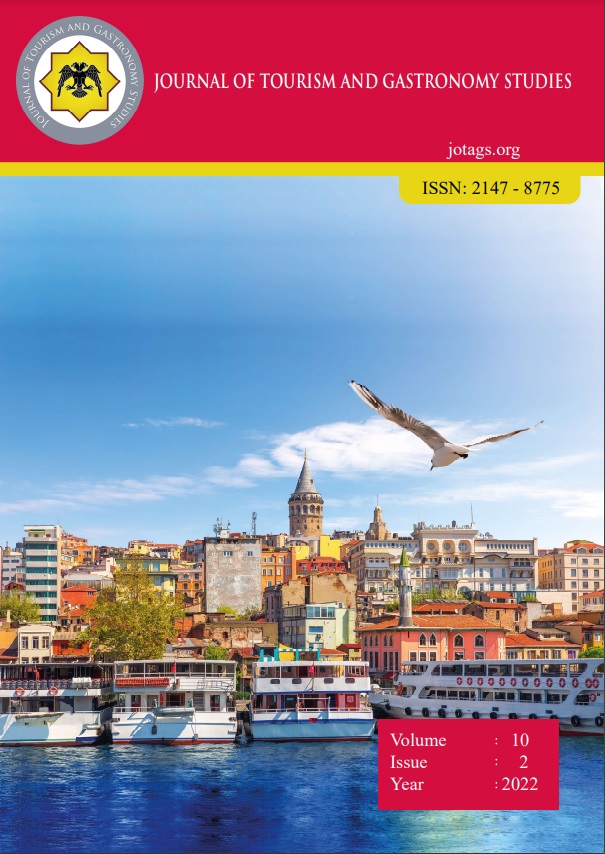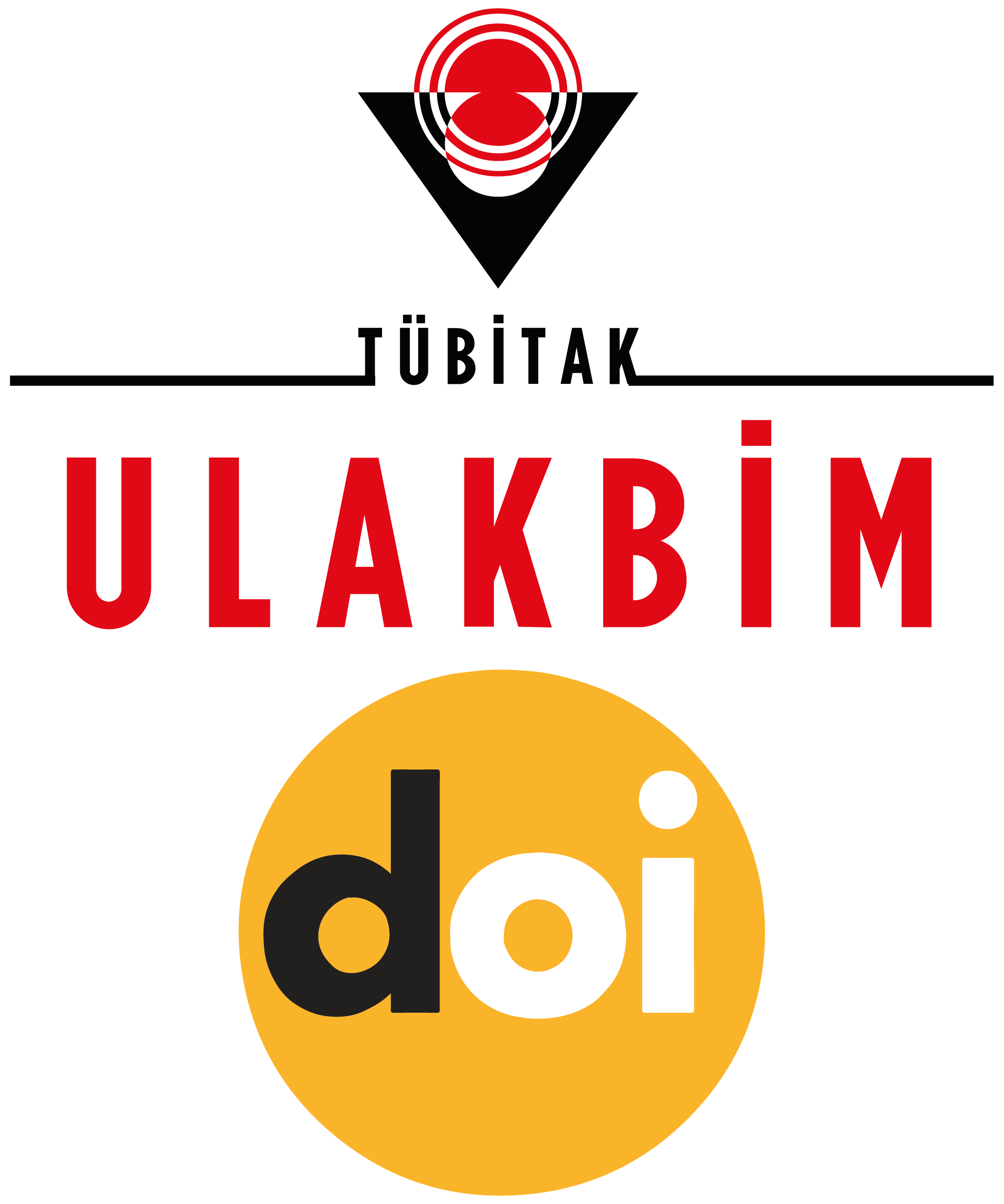Dijital Pazarlama Araçlarından Sosyal Medyanın Yabancı Turistlerin Türkiye’yi Tercihleri Üzerine Etkisi (The Impact of Social Media as a Digital Marketing Tool on Foreign Tourists’choice of Turkey)
DOI:
https://doi.org/10.21325/jotags.2022.1055Keywords:
Social media, Identity, Attitudes, Participation, Community, Consumer behaviorsAbstract
With the increase of social media use for the purposes of obtaining information and ensuring communication, there has been a great effect on the daily lives of the consumers, changing the ways by which individuals communicate with each other and travel. The effect of these developments on tourism companies lead to the increase of presence of travel communities and the occurrence of significant changes in the travel industry. In this research, questions have been directed to the individuals who live in the UK, Germany and Russia and who use social media and have the intention of travelling, in their mother tongues, with the aim of impact of social media on the preference of tourism consumers that have different cultural view points. The data obtained in the research is analyzed with SPSS 25.0 and Smart PLS 3.0 software. While evaluating the data, complementary statistical methods (number, percentage, average, standard deviation) have been used. Comparison tests and frequency analysis were conducted. Besides, explanatory factor analysis and affirmative factor analysis were conducted for reliability related to the adapted scale and the structure validity. According to the results of the research, it could be said that social media has an effect on the behaviors of tourism consumers who have different cultural viewpoints
References
Algesheimer, R., & Dholakia, U. M., & Herrmann, A. (2005). The social influence of brand community: Evidence from European car clubs. Journal of Marketing, 69 (3), 19-34. http://dx.doi.org/10.1509/jmkg.69.3.19.66363
Altunışık, R., Coşkun, R., Bayraktaroğlu, S., & Yıldırım, E. (2010). Sosyal bilimlerde araştırma yöntemleri: SPSS uygulamalı. Sakarya yayıncılık.
Bagozzi, R. P., & Dholakia, U. M. (2002). Intentional social action in virtual communities. Journal of Interactive Marketing, 16(2), 2-21. https://doi.org/10.1002/dir.10006
Bergami, M., & Bagozzi, R. P. (2000). Self‐categorization, affective commitment and group self-esteem as distinct aspects of social identity in the organization. British Journal of Social Psychology, 39(4), 555-577. https://doi.org/10.1348/014466600164633
Buhalis, D., & Law, R. (2008). Progress in information technology and tourism management: 20 years on and 10 years after the Internet-The state of eTourism research. Tourism Management, 29(4), 609-623. https://doi.org/10.1016/j.tourman.2008.01.005
Doğan (2019). SmartPLS ile Veri Analizi (2. Baskı) Ankara: Zet Yayınları, s.46-47.
Dholakia, U. M., Bagozzi, R. P., & Pearo, L. K. (2004). A social influence model of consumer participation in network-and small-group-based virtual communities. International Journal of Research in Marketing, 21(3), 241-263. https://doi.org/10.1016/j.ijresmar.2003.12.004
Altunışık, R., Coşkun, R., Bayraktaroğlu, S., & Yıldırım, E. (2010). Sosyal bilimlerde araştırma yöntemleri: SPSS uygulamalı. Sakarya yayıncılık.
Bhattacherjee, A., & Premkumar, G. (2004). Understanding changes in belief and attitude toward information technology usage: A theoretical model and longitudinal test. MIS Quarterly, 28(2), 229-254. https://doi.org/10.2307/25148634
Casaló, L. V., Flavián, C., & Guinalíu, M. (2010). Determinants of the intention to participate in firm-hosted online travel communities and effects on consumer behavioral intentions. Tourism Management, 31(6), 898-911. doi:10.1016/j.tourman.2010.04.007
Cho, C. H. (2003). The effectiveness of banner advertisements: Involvement and click-through. Journalism & Mass Communication Quarterly, 80 (3), 623-645. doi:10.1177/107769900308000309
Chung, J. Y., & Buhalis, D. (2008). Web 2.0: A study of online travel community. In P. O'Connor, W. Hopken & U. Gretzel (Eds.), Information and Communication Technologies in Tourism 2008 (pp. 70-81). Vienna, Austria: Springer Verlag. doi:10.1007/978-3-211-77280-5_7
Dholakia, U. M., Bagozzi, R. P., & Pearo, L. K. (2004). A social influence model of consumer participation in network-and small-group-based virtual communities. International Journal of Research in Marketing, 21(3), 241-263. doi:10.1016/j.ijresmar.2003.12.004
Durmuş B., Yurtkoru, S.E. ve Çinko, Mç (2013). Sosyal Bilimlerde SPSS’le Veri Analizi (5.Baskı). İstanbul: Beta Yayınları 2013, s.89
Gursoy, D., & McCleary, K. W. (2004). An integrative model of tourists' information search behavior. Annals of Tourism Research, 31(2), 353-373. http://dx.doi.org/10.1016/j.annals.2003.12.004
Hair Jr, J., Black, W., Babin, B., & Anderson, R. (2010). Multivariate data analysis (7th ed.). Upper Saddle River, NJ: Prentice Hall.
Hair, J.F., Ringle, C.M., & Sarstedt, M. (2011). PLS-SEM: Indeed a Silver Bullet: Journal of Marketing Theory and Practice, 19 (2), 139-152. DOI:10.2753/MTP1069-6679190202.
Hair, J.F., Risher, J.J., Sarstedt, M., & Ringle, C.M. (2019). When to use and how to report the results of PLS-SEM. European Business Review. s.9
Hong, S. J., Thong, J. Y. L., Moon, J. Y., & Tam, K. Y. (2008). Understanding the behavior of mobile data services consumers. Information Systems Frontiers, 10 (4), 431-445. doi 10.1007/s10796-008-9096-1
Hsu, C. P., Chiang, Y. F., & Huang, H. C. (2012). How experience-driven community identification generates trust and engagement. Online Information Review, 36 (1), 72-88. doi:10.1108/14684521211206971
Hsu, C. L., & Lin, J. C. C. (2008). Acceptance of blog usage: The roles of technology acceptance, social influence and knowledge sharing motivation. Information & Management, 45 (1), 65-74. doi:10.1016/j.im.2007.11.001
Kwon, O., & Wen, Y. (2010). An empirical study of the factors affecting social network service use. Computers in Human Behavior, 26 (2), 254-263. DOI:10.1016/j.chb.2009.04.011
Nambisan, S., & Baron, R. A. (2007). Interactions in virtual customer environments: Implications for product support and customer relationship management. Journal of Interactive Marketing, 21(2), 42-62. doi:10.1002/dir.20077
Nambisan, S., & Baron, R. A. (2009). Virtual customer environments: Testing a model of voluntary participation in value co-creation activities. Journal of Product Innovation Management, 26 (4), 388-406. doi:10.1111/j.1540-5885.2009.00667.x
Rich, B. L., Lepine, J. A., & Crawford, E. R. (2010). Job engagement: Antecedents and effects on job performance. The Academy of Management Journal (AMJ), 53 (3), 617-635. https://doi.org/10.5465/AMJ.2010.51468988
Schaufeli, W. B., Salanova, M., González-Romá, V., & Bakker, A. B. (2002). The measurement of engagement and burnout: A two sample confirmatory factor analytic approach. Journal of Happiness Studies, 3 (1), 71-92. https://doi.org/10.1023/A:1015630930326
Sigala, M. (2011). eCRM 2.0 applications and trends: The use and perceptions of Greek tourism firms of social networks and intelligence. Computers in Human Behavior, 27 (2), 655- 661. doi:10.1016/j.chb.2010.03.007
Qu, H., & Lee, H. (2011). Travelers' social identification and membership behaviors in online travel community. Tourism Management, 32 (6), 1262-1270. doi: 10.1016/j.tourman.2010.12.002
Tavşancıl, E. (2005). Tutumların Ölçülmesi ve SPSS İle Veri Analizi. Ankara, Nobel Basımevi. s:19
Ural, A. ve Kılıç, İ. (2006). Bilimsel Araştırma Süreci ve SPSS ile Veri Analizi. (Genişletilmiş İkinci Baskı), Ankara: Detay Yayıncılık. s. 286
Van Doorn, J., Lemon, K. N., Mittal, V., Nass, S., Pick, D., Pirner, P., & Verhoef, P. C. (2010). Customer engagement behavior: Theoretical foundations and research directions. Journal of Service Research, 13(3), 253-266. https://doi.org/10.1177/1094670510375599
Wang, Y., Yu, Q., & Fesenmaier, D. R. (2002). Defining the virtual tourist community: implications for tourism marketing. Tourism Management, 23(4), 407-417. doi:10.1016/S0261-5177(01)00093-0
Wu, I. L., & Chen, J. L. (2005). An extension of trust and TAM model with TPB in the initial adoption of on-line tax: an empirical study. International Journal of Human-Computer Studies, 62(6), 784-808. doi:10.1016/j.ijhcs.2005.03.003
Xiang, Z., & Gretzel, U. (2010). Role of social media in online travel information search. Tourism Management, 31(2), 179-188. https://doi.org/10.1016/j.tourman.2009.02.016
Wang, Y., Yu, Q., & Fesenmaier, D. R. (2002). Defining the virtual tourist community: implications for tourism marketing. Tourism Management, 23(4), 407-417. doi:10.1016/S0261-5177(01)00093-0
Wang, Y., & Fesenmaier, D. R. (2004). Modeling participation in an online travel community. Journal of Travel Research, 42(3), 261-270. https://doi.org/10.1177/0047287503258824
http//:www.virtourist.com
https://wearesocial.com/uk/blog/2022/01/digital-2022-another-year-of-bumper-growth-2/
Downloads
Published
How to Cite
Issue
Section
License
Copyright (c) 2023 Journal of Tourism & Gastronomy Studies

This work is licensed under a Creative Commons Attribution-NonCommercial 4.0 International License.








